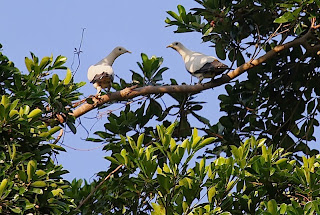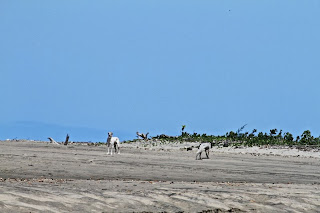Queensland is baking in heatwave and drought conditions. The monsoon failed last year and western Queensland farmers are in dire circumstances. Here on the coast the water table has fallen to the lowest I have ever seen and there is no sign of the monsoon any time soon.
The Bureau of Meteorology seasonal outlook advises that the El Nino-Southern Oscillation (ENSO) indicators remain within neutral bounds: sea surface temperatures are close to their long-term average while weak cool anomalies have appeared in the Coral Sea. This all means a drier than normal season is more likely for large parts of eastern Australia.
At this time of the year you seldom see sunrise because of rain, now dust and smoke haze are creating spectacular sunrises and sunsets: such as this reflecting-sunrise at Coquette Point this morning 5.46am.
 The cassowaries are seeking out cool places to rest in the heat of the day and every day Snout brings his chick into a small pond behind the nursery. The chick runs ahead and drinks deeply before Snout stirs up the water.
The cassowaries are seeking out cool places to rest in the heat of the day and every day Snout brings his chick into a small pond behind the nursery. The chick runs ahead and drinks deeply before Snout stirs up the water.

The chick hops in beside dad and they both cool off in the water. Then Snout get serious about cleaning his feathers. The chick watches his father intently.

 Snout washes behind the chicks ears and encourages him into the water.
Snout washes behind the chicks ears and encourages him into the water.
 The chick bobed up and down in the water enjoying itself and did not notice that Snout had decided to leave. In a panic it ran from the water and caught up with Dad. They dried off in the sun before they left for the rainforest.
The chick bobed up and down in the water enjoying itself and did not notice that Snout had decided to leave. In a panic it ran from the water and caught up with Dad. They dried off in the sun before they left for the rainforest.
The matriarch Jessie is still feeding at the Damson Plum every day.
 She crosses the road from 27V visits all the fruiting trees then returns the way she came.
She crosses the road from 27V visits all the fruiting trees then returns the way she came.Q still hold to the river side and this morning as I came back from my walk I saw him standing out on the sandbar picking at fiddler crabs.
 As soon as he saw me he disappeared into the mangroves. Poor Q is harassed by Jessie and Snout and is very timid.
As soon as he saw me he disappeared into the mangroves. Poor Q is harassed by Jessie and Snout and is very timid.
At the moment the cassowary scats consist mainly of the Damson Plum and a few Native Olives; this scat is from the chick.

The Pied Imperial Pigeons are still the birds mostly responsible for the bounty of plums on the forest floor.

From a distance the PIPs look like snow on the branches of the Damson.
20 to 30 PIPs are feeding on the Damson's sweet fruits at any one time.
This week King tides up to 3.38 m and lows of 0.17 m have flushed the river and as there has been no rain the water is clear and bait-fish can be seen jumping and swirling in the shallows.
The tide starting to rush into the mouth of the Johnstone River pushed by a fresh nor-easterly. Here the highest mountain in Queensland, Mount Bartle Frere, dominates the skyline. Normally, at this time of year, Bartle Frere is clothed in cloud and mist and the waters of the Johnstone River are turbid from runoff.
What better way to spend the first days of the New Year than to walk on the beach at Coquette Point. To my delight I found four Ruddy Turn-stones searching for crustaceans in the mud around the mangrove roots and in the sand on the flats. They arrived early in the week when I took these photos and I saw them again in the same area this morning.


I have only seen one Ruddy turn-stone at Coquette Point before, however, it is on Billie Gill's bird list for Coquette Point sightings 1966 to 1970.
These birds are like little bulldozers turning over pebbles and seaweed looking for insects or tiny crabs.
In breeding plumage the chest patch turns black with two black bars, one in a distinct circle from wingtip to wingtip and the other around the neck. The wings change from turtle-shell to a deep chestnut complementing there bright orange stocky legs. Many shorebirds still carry their breeding plumage when they arrive in late Winter. Ruddy turnstones breed in the Arctic and sub-Arctic regions and are known to travel over 76,000 kilometres in their migratory journey.
Ruddy turnstones populations are strong and although they are not at the moment endangered or vulnerable the wider populations of all migratory shorebirds are falling and of concern.

 On the outer sand banks Crested terns were resting with some juveniles, one Caspain tern and nine Little terns. In the waters off shore, more little terns were fishing they were too far out to photograph, however I could hear their distinct call. Some of the little terns were in non breeding plumage.
On the outer sand banks Crested terns were resting with some juveniles, one Caspain tern and nine Little terns. In the waters off shore, more little terns were fishing they were too far out to photograph, however I could hear their distinct call. Some of the little terns were in non breeding plumage.



A little tern arrived with a fish and dropped into shallow water and appeared to be mating with another tern in the water. Unfortunately I could not get camera focus on the little terns, it was all happening too quickly.

It was good to see that the King tides did not come near the top of the dune. A good cover of casuarinas and pig-weed has now stabilised the dune and sand is continuing to build at the top of the dune.

 What is disappointing is that people are still ignoring the 'no dog' and World Heritage signs and walking dogs into the World Heritage migratory shorebird habitat and directly across the rookery. Of course I spoke politely to them all.
What is disappointing is that people are still ignoring the 'no dog' and World Heritage signs and walking dogs into the World Heritage migratory shorebird habitat and directly across the rookery. Of course I spoke politely to them all.Two very large dogs ran right across the rookery then straight at me before their owners could call them to heel.

The dog on the right, although on a lead, ran at me growling before the owner could restrain it.
Not only are dogs devastating for migratory shore-birds but large unrestrained dogs are a real danger to people walking on beaches, particularly children, and now in the school holidays it is an accident waiting to happen.


This morning I also saw large numbers of eastern curlews and Pacific golden plovers.
There were many groups of plovers spread out over the sand flats.


A pair of pied oyster-catches were feeding on the edge of the pools.
Casuarina equisetifolia is in flower behind the dunes at the end of Coquette Point and the early morning sun's rays lit the catkin-like inflorescences and turned them to gold. Casuarina species are a food source for the larvae of hepialid and noctuid turnip moth.
I hope you also find a little gold in your life.
Cheers,
Yvonne.








No comments:
Post a Comment